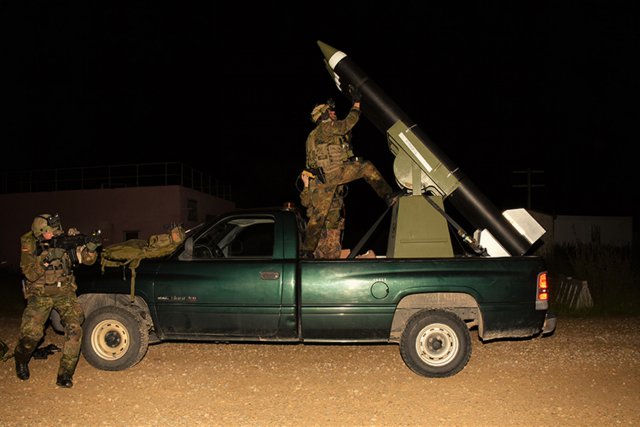 |
| Green Berets from 3rd Special Forces Group demonstrate room clearing for German Rangers in Hohenfels, Germany during NATO exercise Swift Response. |
By: Wording OD
Special operation forces conduct some of the most strenuous and
sophisticated military operations in the world. SOF units are known to be
highly trained and often better equipped than traditional soldiers. Yet one of
their most valuable assets is very low-tech relationships. "We don't fight alone," said Maj. Bobby
Temple, officer in charge of the SOF Cell with the Joint Multinational
Readiness Center. "We train and work together in a realistic environment
that facilitates SOF capability development."
 |
The 3rd Special Forces Group, together with the
German 31st Airborne Regiment, conducted shaping operations during a conflict
near the fictional Atropia/Ariana border as part of exercise Swift Response 16
at the Hohenfels Training Area, June 1-16, 2016. "There was enemy air defense artillery
systems that were prepared to destroy the 1st Brigade 82nd Division," said
Temple. The SOF mission was locate and then destroy those enemy ADA systems,
and enabled the jump to happen.
 |
| The exercise is one of the premier military crisis response training events for multinational airborne forces in the world. |
The exercise is one of the premier military
training events for multinational airborne forces in the world. The training
enhances the readiness of the 82nd Airborne's 1st Brigade Combat Team to
conduct rapid-response, joint forcible entry and follow-on operations alongside
European Allies and SOF organizations. "Right now, as an allied and partnered force,
everyone is trained at a level where they can operate on their own," said
Temple. "However when we go on missions, in a real world event, we are
always working together. We need to improve that capability because it becomes
an extreme issue on the ground to not be able to communicate."
 |
| ( |
Something as simple as fueling a vehicle can turn
into a major issue during a deployment when considering language barriers,
differences in equipment and operating procedures. During Swift Response, SOF
units improve interoperability with other American and Allied units they are
likely to encounter during a real-world mission. "You're talking the exact guys you'll be
working with in country," said Temple. "We establish the scenario to
have the two elements [SOF and conventional forces] working in a single
environment. It's hitting the two birds; the primary piece is to have SOF and
conventional forces integration, interoperability and interdependence, and the secondary
piece is SOF capability development."
 |
Here, U.S. SOF organizations have the opportunity
to train with multinational SOF units and share best practices and procedures
with each other. Although these operators are experts in their field, exchanging
knowledge across nations is always beneficial. "I think a myth might be that we're like
shadow warriors… and that we're fully aware of every threat out there in the
world," said Sgt. Maj. Timo Braese, with the German 31st Airborne
Regiment. "The reality is… you still have to be very proficient and have
that right mindset, and to do that you have to stay in training. This is why
we're here."
The Hohenfels Training Area is flexible, and can
mimic a real SOF mission environment. As global threats change, training
objectives adapt. Unit members may move on, but relationships between units
will continue being developed. Even though there are many changes that may come,
there is one certainty, "this is the future," said Braese. "We
all have to move together and train together in order to accomplish common
tasks."
SOURCE: army.mil

Nenhum comentário:
Postar um comentário